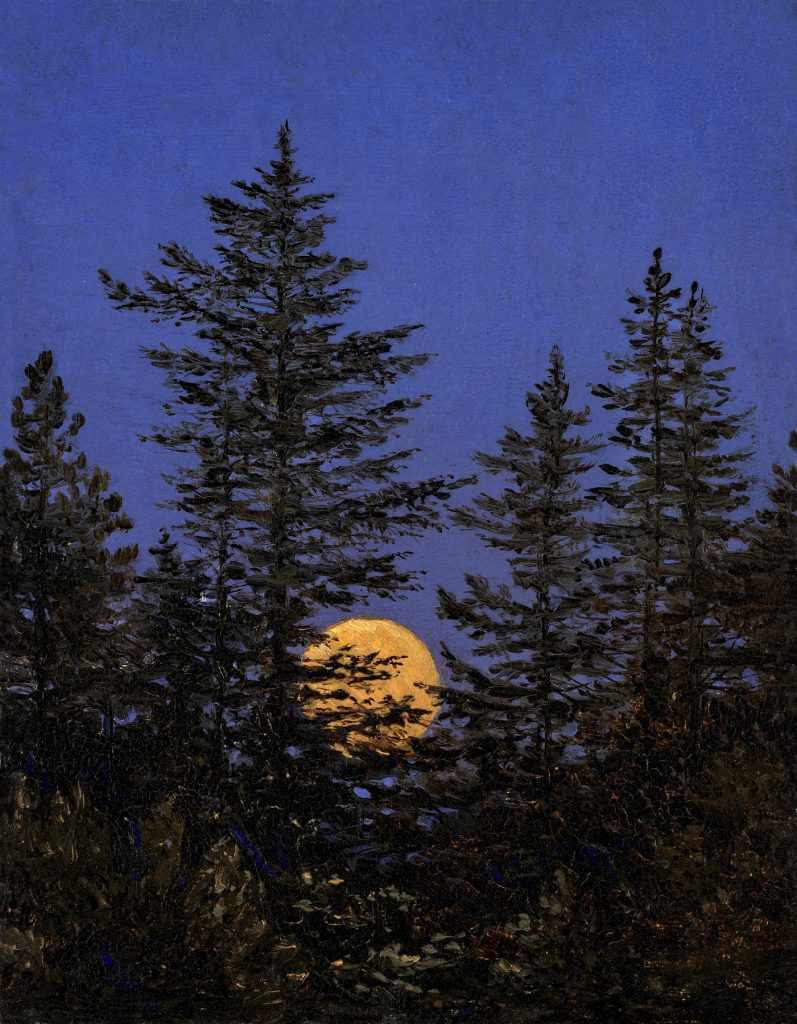Carl Gustav Carus (Leipzig 1789 - 1869 Dresden)
Moon Rising Behind Pines
Oil on board
10.2 x 8 cm
Provenance:
Franz Ulrich Apelt collection, Zittau
We are grateful to Dirk Gedlich, Dresden, who has confirmed the attribution to Carus after examining the painting in the original. He will be including it in the revised edition of the Carus catalogue raisonné compiled by Marianne Prause.
Carl Gustav Carus’s small-format night painting depicts the motif of a full moon rising behind pines – images of the moon are one of the key motifs of Romantic artists working in Dresden. The ‘darkening’[1] blue (as Carus himself describes it) of the clear night sky has a crystalline intensity. The ‘pale-golden’ orb (again, Carus’s description) of the full moon has a fine, reddish coronal ring. The jagged blackness of the pyramidal crowns of the pines contrasts with the clear blue of the moonlit sky. Specks of highlighting on the foreground vegetation are designed to simulate the reflected gleam of the moonlight. The lowish viewpoint that Carus chose and the heightened contrasts that he achieved through the use of an almost monochrome palette combine to lend the painting an added dimension independent of both format and subject.
Carus’s interest in night views and the depiction of moonlight is documented by the large corpus of moonlight landscapes he produced in the course of his career.[2] However, only on one other occasion did he handle the subject in miniature dimensions and with concentrated focus. This painting is now in the collection of the Germanisches Nationalmuseum in Nuremberg (fig. 1).[3] Carus devotes a whole chapter in his Briefe über Landschaftsmalerei to what he describes as ‘moonlight pictures’.[4] In his theoretical writings he reveals himself as a natural scientist and an ‘intelligent landscapist’.[5] Taking the Romantic synthesis of ‘sentiment’ and ‘nature’, he sought to combine this with a determination to objectify the representation of nature. His representation of a rising moon therefore contained – in addition to aesthetic elaboration – a precise study of the conditions of light and colour, namely, as he writes, the manner in which [the rising moon] defined itself in the fullness of its colour, yet in deep dusk, against the clear sky, that being, to a degree, still illuminated by the light of the setting sun, and ... against the darkening blue of the sky, the clear, ... outline of the moon ... emerged. [6]
Carus settled in Dresden in 1814. He was a friend of Caspar David Friedrich and a leading member of his circle. It was Friedrich who established moonlight as a major theme in Romantic painting. Although Carus began to distance himself from the Friedrich circle in the 1820s, Friedrich’s profound knowledge of painting techniques and compositional methods had a lasting influence on his work. Carus was to draw on Friedrich’s aesthetic principles and teaching for the rest of his career. On Friedrich’s death he wrote: Of great value to me was the distinct feeling for pure concentration of light that marked his [Friedrich’s] works.[7]
[1] [... (das) dunkelnde (Blau)...; ... (der) bleichgolden (Vollmond) ...] See Carl Gustav Carus, ‘Zehnter Brief’, in Zehn Briefe und Aufsätze über Landschaftsmalerei mit zwölf Beilagen und einem Brief von Goethe als Einleitung, 1815-35, Leipzig and Weimar 1982, p.118 and p.116. [2] For a comparison of motifs and technique, see Carl Gustav Carus. Natur und Idee, exhib. cat., Dresden, Staatliche Kunstsammlungen and Berlin, Staatliche Museen, June 2009 - January 2010, Dresden and Berlin 2009, ‚Natur und Idee’, nos. 106-7, 117 and 142. [3] Carl Gustav Carus, Full Moon over Pines, oil on panel, 10.5 x 7 cm, Germanisches Nationalmuseum, Nuremberg, inv. no. GNM 2060. [4] [Mondscheinbilder] See Carl Gustav Carus, Zehn Briefe …, op. cit., pp.115-9. [5] [(Ein) geistreicher Landschaftsmaler.] See Kendrik Karge, ‘Die Landschaftsbriefe von Carl Gustav Carus und ihre Rezeption in der zeitgenössischen Kritik und Kunstliteratur’, in Carl Gustav Carus, op. cit., ‚Essays’, 233 ff. [6] [Wie sich das so vollgefärbt und doch in tiefer Dämmerung von dem reinen, durch das Licht der untergegangenen Sonne noch mäßig erleuchteten Himmel absetzt, und ... auf dunkelndem Blau des Himmels der reine, … erscheinende Mond… hervortrat.] Carl Gustav Carus, Zehn Briefe…, op. cit., p.118. [7] [Sehr lehrreich für mich war das entschiedene Gefühl für reine Konzentration des Lichts, welches seine Werke auszeichnete.] Carl Gustav Carus, ‘Lebenserinnerungen und Denkwürdigkeiten’, in Caspar David Friedrich in Briefen und Bekenntnissen, Sigrid Hinz (ed.), Munich 1974, p.194.

